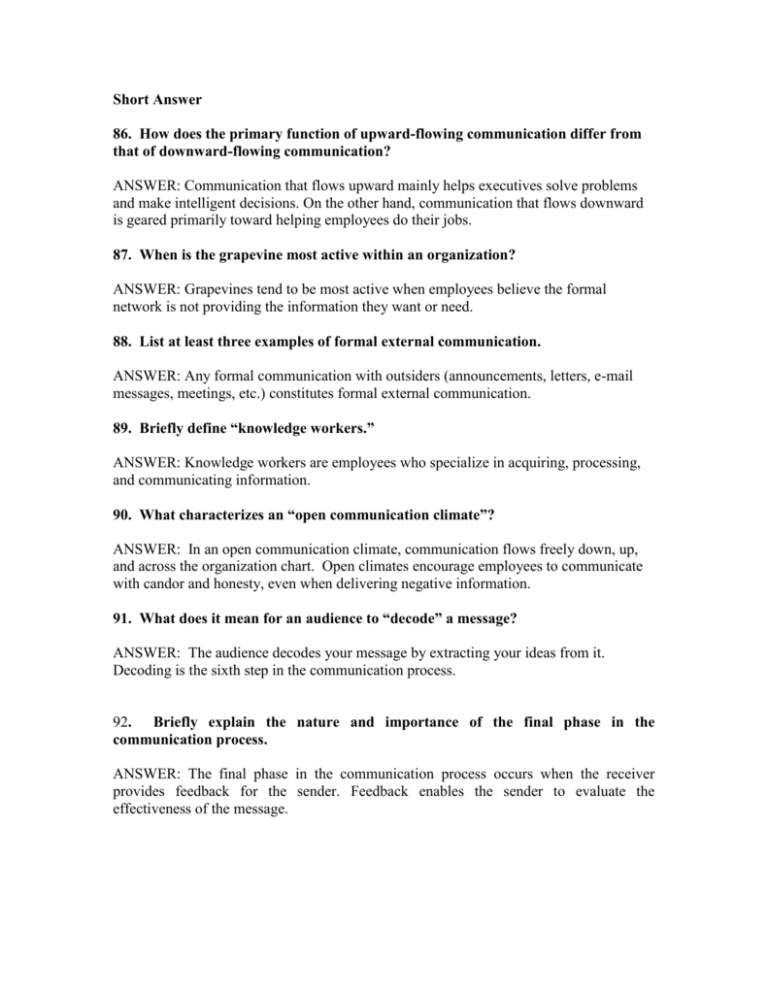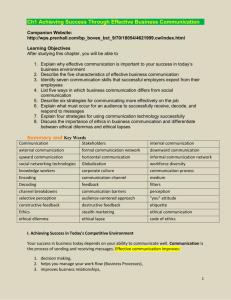File
advertisement

Short Answer 86. How does the primary function of upward-flowing communication differ from that of downward-flowing communication? ANSWER: Communication that flows upward mainly helps executives solve problems and make intelligent decisions. On the other hand, communication that flows downward is geared primarily toward helping employees do their jobs. 87. When is the grapevine most active within an organization? ANSWER: Grapevines tend to be most active when employees believe the formal network is not providing the information they want or need. 88. List at least three examples of formal external communication. ANSWER: Any formal communication with outsiders (announcements, letters, e-mail messages, meetings, etc.) constitutes formal external communication. 89. Briefly define “knowledge workers.” ANSWER: Knowledge workers are employees who specialize in acquiring, processing, and communicating information. 90. What characterizes an “open communication climate”? ANSWER: In an open communication climate, communication flows freely down, up, and across the organization chart. Open climates encourage employees to communicate with candor and honesty, even when delivering negative information. 91. What does it mean for an audience to “decode” a message? ANSWER: The audience decodes your message by extracting your ideas from it. Decoding is the sixth step in the communication process. 92. Briefly explain the nature and importance of the final phase in the communication process. ANSWER: The final phase in the communication process occurs when the receiver provides feedback for the sender. Feedback enables the sender to evaluate the effectiveness of the message. 93. How can the exchange of numerous messages become a barrier to effective communication? ANSWER: The sheer number of messages that people receive on the job can be distracting. Too many messages can result in information overload, which not only makes it difficult to discriminate between useful and useless information but also amplifies workplace stress. 94. To adopt an audience-centered approach to communication, what do you need to learn about your audience? List at least three specific examples. ANSWER: An audience-centered approach requires learning as much as possible about the receiver’s biases, education, age, social status, style, and point of view. 95. Briefly explain the difference between an ethical dilemma and an ethical lapse. ANSWER: You face an ethical dilemma when you must choose between two or more conflicting alternatives that both seem valid and ethical. An ethical lapse, on the other hand, occurs when you make a choice that is clearly unethical and or illegal. An ethical dilemma can lead to an ethical lapse but doesn’t necessarily do so. Essay 96. Describe the various directions communication flows through an organization’s formal network, and give an example of each one. ANSWER: Communication travels upward, downward, and horizontally through an organization’s formal hierarchy. An example of upward flowing communication would be an employee sending an e-mail to his or her supervisor requesting clarification of a new company policy. The manager’s response would flow downward. Horizontal communication would include a memo from the production manager to the shipping manager warning of an impending delay. ****97. Describe at least five common characteristics of effective business messages. Effective business messages provide practical information that immediately helps receivers in concrete ways. They also give facts rather than impressions, focusing on what is rather than on what could, should, or might be. They present information in a concise, efficient manner. Finally, effective business messages state precise responsibilities, persuade others, and offer recommendations rather than simply pointing out problems. 98. Briefly describe the eight steps of the communication process. ANSWER: The first step in the communication process occurs when the sender has an idea and decides to share it. Second, the sender encodes the idea as a message that the receiver will understand. Third, the sender produces the message in a transmittable medium. Fourth, the sender transmits the message through a channel (such as a face-toface conversation or an e-mail). Fifth, the audience receives the message. Sixth, the audience decodes the message by extracting your idea from it. Seventh, the audience responds the message. Eighth, the audience sends feedback that helps the sender evaluate the effectiveness of the communication effort. ***99. Describe four common types of communication barriers. ANSWER: Four common types of communication barriers are noise and distractions, competing messages, filters, and channel breakdowns. Noise and distractions can be both physical and emotional and are especially common due to the widespread habit of multitasking. Competing messages make it difficult to gain and keep your audience’s attention and can result in information overload, which makes it difficult to distinguish between useful and useless information, and increases workplace stress. Messages can be blocked or distorted by filters, which are any human or technology intervention between the sender and the receiver. Filtering can be intentional or unintentional. Finally, channel breakdowns occur when the channel you select fails to deliver your message at all. 100. Describe five strategies for overcoming communication barriers and briefly explain what each one of these strategies requires. ANSWER: The first strategy for overcoming common communication barriers is to minimize distractions by reducing noise and interruptions and sending fewer messages. Second, adopt an audience-centered approach. Doing so requires learning as much as possible about your audience and tailoring your message to suit the receiver’s needs and point of view. Third, effective communication requires fine-tuning your business communication skills. Fourth, provide and respond to constructive feedback. This involves focusing on the process and outcomes of communication (not the faults or failures of the people involved) and learning to view your work as something you can improve. Finally, be sensitive to business etiquette, since the way you conduct yourself can have a profound impact on your company’s success and reputation.




